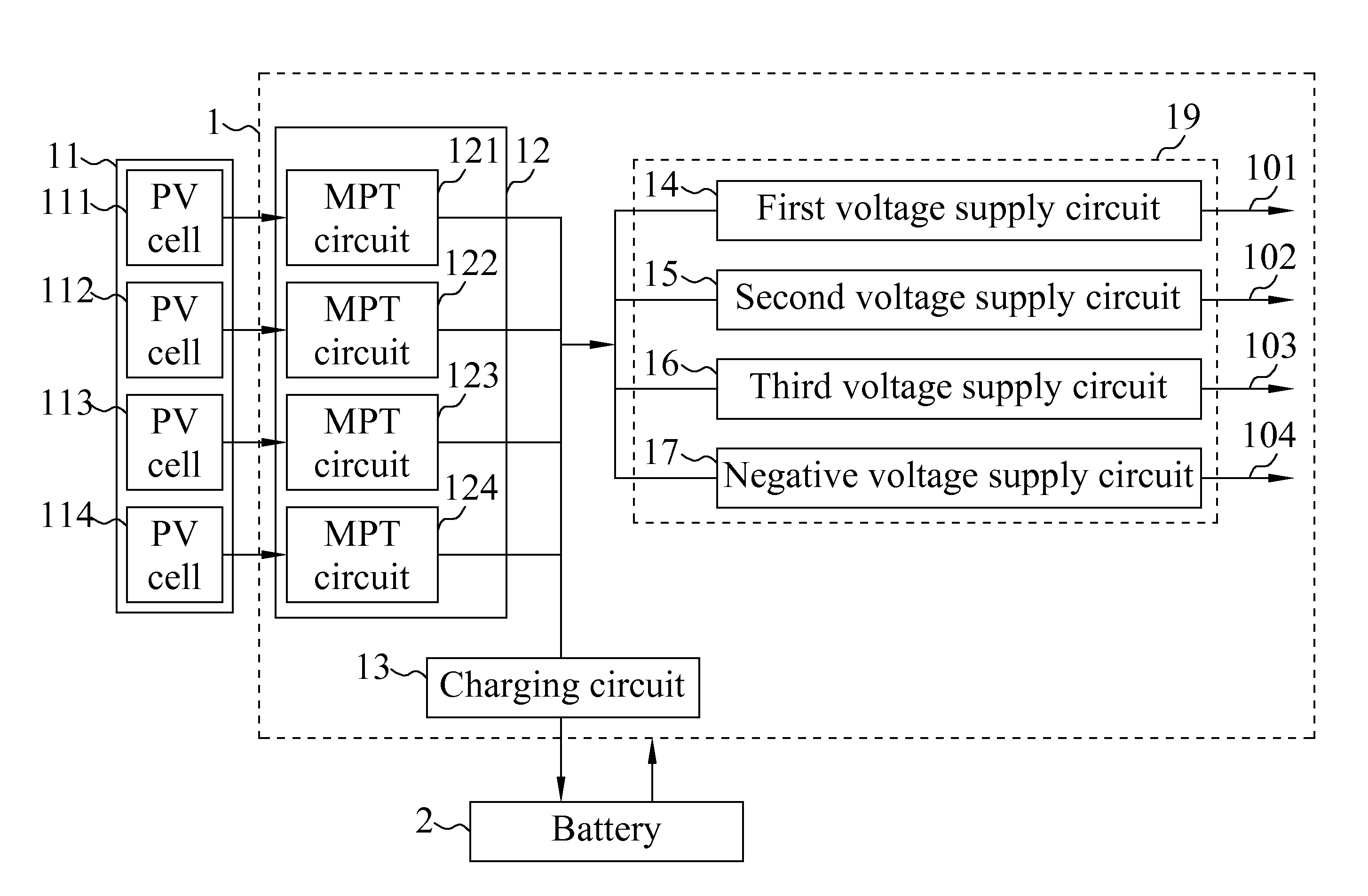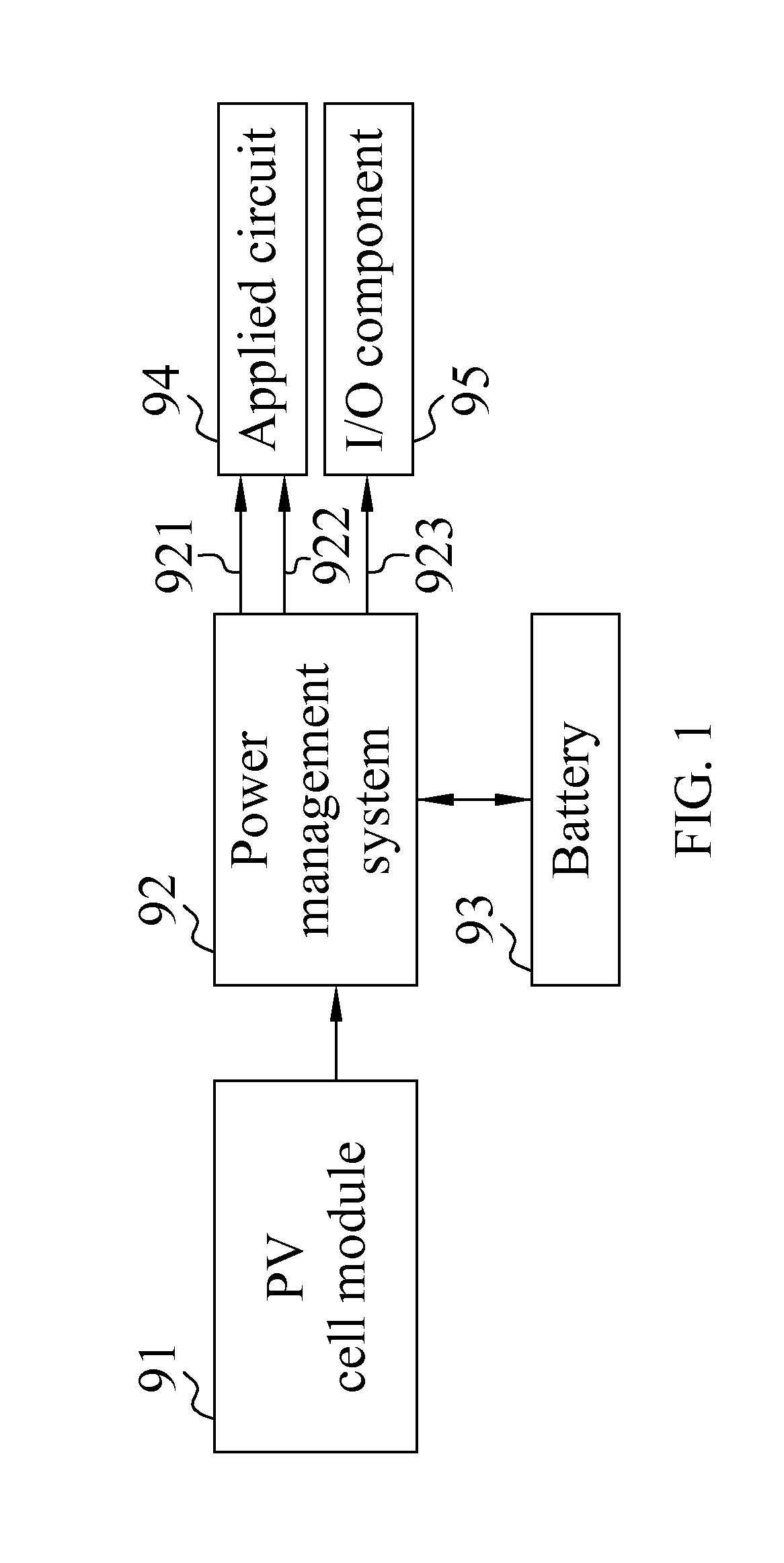Solar power management system
a solar power management and solar energy technology, applied in the field of solar power management system, can solve the problems of low sunlight energy conversion efficiency, largely increased demand of people for more energy sources, and environmental pollution
- Summary
- Abstract
- Description
- Claims
- Application Information
AI Technical Summary
Benefits of technology
Problems solved by technology
Method used
Image
Examples
first embodiment
Please refer to FIG. 2 that is a block diagram of a solar power management system 1 according to a first embodiment of the present invention. As shown, the solar power management system 1 is manufactured as a system on chip (SoC) and is connected to an output end of a photovoltaic cell 111 for managing the electric energy conversion by the photovoltaic cell 111, supplying the converted electric energy to an external load, and storing surplus electric energy in a battery 2. The solar power management system 1 comprises a maximum power tracking (MPT) circuit 121, a charging circuit 13, and a voltage conversion module 19. The MPT circuit 121 causes the photovoltaic cell 111 to output electric energy with a maximum power, and the voltage conversion module 19 converts the electric energy with the maximum power into a setting voltage for use by an external load. In the illustrated first embodiment, the voltage conversion module 19 comprises a first voltage supply circuit 14, a second volt...
second embodiment
The solar power management system 1 according to the second embodiment of the present invention is structurally similar to the first embodiment as shown in FIG. 2, and comprises an MPT circuit 121, a charging circuit 13, and a voltage conversion module 19. The voltage conversion module 19 further comprises a first voltage supply circuit 14, a second voltage supply circuit 15, a third voltage supply circuit 16, and a negative voltage supply circuit 17. Please refer to FIG. 5. The third voltage supply circuit 16 comprises a comparison circuit 1601, a finite-state machine 1602, and a switched-capacitor DC-DC converter 1603. The switched-capacitor DC-DC converter 1603 further comprises a first switched capacitor matrix 16031 and a second switched capacitor matrix 16032. The comparison circuit 1601 compares a reference voltage Vref with a feedback voltage Vout for the finite-state machine 1602 to output a control signal according to a comparison result from the comparison circuit 1601, s...
third embodiment
Please refer to FIG. 3 that is a block diagram of a solar power management system 1 according to a third embodiment of the present invention for use with a photovoltaic cell module 11. In the illustrated third embodiment, the photovoltaic cell module 11 comprises four photovoltaic cells 111, 112, 113, 114, which are connected in parallel to form an array. However, it is understood the number and the connecting manner (in parallel or in series) of the photovoltaic cells included in the photovoltaic cell module 11 are not necessarily restricted to the above mentioned number and connecting manner. The solar power management system 1 in the third embodiment comprises four MPT circuits 121, 122, 123, 124; a charging circuit 13; and a voltage conversion module 19. The four MPT circuits 121, 122, 123, 124 together constitute a multiphase maximum power tracking (MPT) module 12, and respectively correspond to the four photovoltaic cells 111, 112, 113, 114. Further, the four MPT circuits 121,...
PUM
| Property | Measurement | Unit |
|---|---|---|
| voltage | aaaaa | aaaaa |
| voltage | aaaaa | aaaaa |
| voltage | aaaaa | aaaaa |
Abstract
Description
Claims
Application Information
 Login to View More
Login to View More - R&D
- Intellectual Property
- Life Sciences
- Materials
- Tech Scout
- Unparalleled Data Quality
- Higher Quality Content
- 60% Fewer Hallucinations
Browse by: Latest US Patents, China's latest patents, Technical Efficacy Thesaurus, Application Domain, Technology Topic, Popular Technical Reports.
© 2025 PatSnap. All rights reserved.Legal|Privacy policy|Modern Slavery Act Transparency Statement|Sitemap|About US| Contact US: help@patsnap.com



